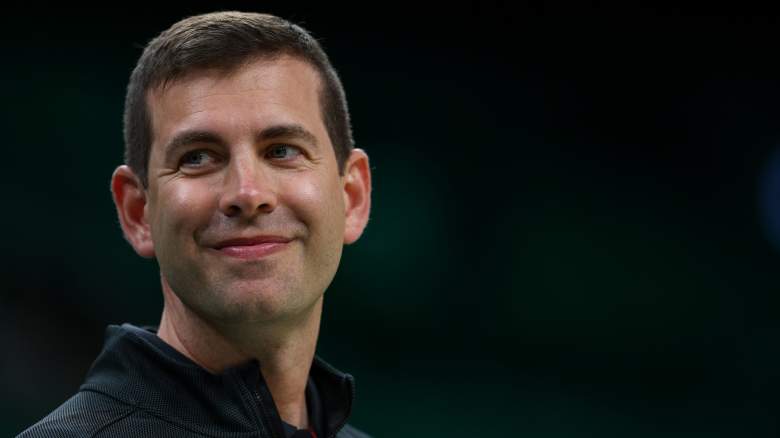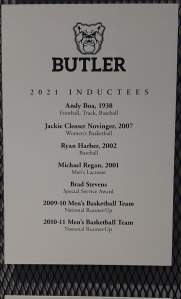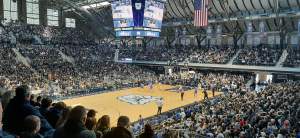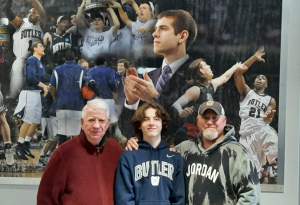
Getty Brad Stevens, Celtics president
INDIANAPOLIS — On the concourse wall near the southwest corner of Hinkle Fieldhouse, Brad Stevens is inches from expressionless. The look belies the turning wheels within.
His picture is part of a montage that runs for yards and yards down the hallway, lit mostly by the sun this past Saturday afternoon. He appears then as Butler University coach more than 10 years ago much as he does today as Celtics president of basketball operations.
Some stop and point as they make their way in for the Butler-Creighton duel. Others take photos. To them and the many in the crowd wearing Gordon Hayward throwback jerseys, Stevens represents the greatest era in the school’s hoop history, trips to the NCAA championship game in 2010 and 2011.

Steve BulpettButler 2021 Hall of Fame inductees, including Brad Stevens
Boston Brad is deeply rooted in Indiana Brad, and you have to understand the latter to see how he’s again maneuvered the Celtics into position to compete for an NBA title.
Stevens had plans to be here on this day, but the last week’s “storm that wasn’t” postponed son Brady’s senior day game to Saturday. His trip to Indy officially abandoned, he is on the phone the night before.
“I’d like to go,” Stevens tells Heavy Sports, “but this is the time to make sure that I’m at the games I need to be at.”
Brad Stevens ‘Knows What He Wants to Do’
At halftime Saturday, Barry Collier cuts a regal figure in the Hinkle hallway, a blue pinstripe suit fitting perfectly on his 6-foot-7 frame. The athletic director who handed the keys to Stevens saw beyond the stoic look on the wall in 2007, and he understands well how someone who’d look at home singing along at St. Luke’s United Methodist could figuratively belt out some John Mellencamp when needed.

Steve BulpettHinkle Fieldhouse, home of Butler basketball
“He knows what he wants to do,” says Collier. “He has a really very thorough process to find a potential solution to something, but then follows through on it.
“And what is often missed because of his somewhat mild demeanor is that he’s really a fiery competitor. He just doesn’t wear it on the outside.”
Brad Stevens does, however, wear it in the transactions column. There was evidence of much behind the poker face early on, but “fiery” may not be enough to describe a guy whose team gets to the NBA Finals his first year on the job and within a game of the title series the second — then changes out 40% of his starting lineup.
That kind of thing takes nerve.
While others saw a group that had been knocking on the championship door and was ready to do so again, Stevens saw danger in stagnation.
“I think we’re always evaluating how we can get better, because I think if you’re not trying to get better, you’re probably going to get caught,” he tells Heavy of the thinking behind the acquisitions of Kristaps Porzingis and Jrue Holiday. “And, you know, we weren’t where we wanted to be anyways as far as a Finals or championship team. So getting caught is just something that I just think you always have to be alert to.
“Being good is really fragile. Being good is really hard. And nothing is guaranteed, so you just, again, have to be on the lookout for ways to improve. Most of the time, that’s just within the walls — tweak the offense, tweak the defense, whatever the case may be. But sometimes opportunities present themselves, and you just have to be ready.”
Deep Roots in Indiana & at Butler
While his NBA brain may have been established in Boston, Brad Stevens the person — ready for opportunities presented — was crafted in this city and state. And this building.
On the rare occasions he is able to return to this historic fieldhouse, Stevens is welcomed as Butler royalty.
“When he comes back, it’s obviously a big deal,” says Alex Barlow, who played for Stevens here, coached under him with the Celtics and has returned to Butler this year as an assistant coach. “And now that he’s with the Celtics, it makes it even more of a big deal, because the Celtics are THE basketball franchise in North America.
“And there’s a lot of Celtics fans here because of Larry Bird being from Indiana and playing for the Celtics and all that. So when you take Butler and the Celtics and tie it all together, yeah, he’s kind of a big deal here.”
Says Collier, “We will never let go of Brad Stevens. We consider him to be part of the family and a major factor in Butler’s rise as a university, much less in athletics or basketball.”
The Celtics and Boston certainly don’t wish to lose their grasp on Stevens either. While he has yet to stitch a banner to fill the next empty home in the Garden rafters, his years as coach and now head of basketball ops have been among the best in the NBA. And here at the All-Star pause with 27 regular season games left, the Celts own, by four games overall and six in the Eastern Conference, the best record in the league.
After taking over in the wake of Doc Rivers’ departure and the trading of Paul Pierce and Kevin Garnett in 2013, Stevens went 25-57 in that construction zone of a season. As the rebuilding continued toward contendership, he had a .594 winning percentage over his last seven years on the bench.
In the third year following an ascension to the front office that caught most off guard, he’s doing quite well with a gig that’s far larger than outsiders generally realize.
“We’re always thinking about how to improve the team and make the team better. I think we’re always evaluating the team,” Stevens says. “But as far as true roster construction, I’d say it’s not as big a percentage of the job as everybody thinks it is. You’re responsible for the entire basketball operation. So you’re responsible for all the people in the building, all of their employment and everything that goes with that.
“The big moments of the trade deadline and the draft are what everybody focuses on and what gets talked about. They’re certainly the time of highest stress. But I do think the day to day is just like if you’re part of the leadership group of any other organization, I would assume.”
He’s therefore approached the position like a true basketball businessman.
“I feel very, very responsible for putting a team together that not only includes the players, but coaches, trainers, nutrition, analytics and everyone else that is on one page and represents the Celtics really well,” Stevens says.
“We will be judged on how well we play and how many games we win and our competitive character that we exhibit through it. So just putting all of the right people in all of the right spots to do that is, I think, the No. 1 responsibility. Get the right people on the bus, and make sure that we’re all moving in one direction.”
Brad Stevens ‘Took a Lot’ From Danny Ainge
And while Stevens is clearly cutting his own path, he gathered much from predecessor Danny Ainge, who stunned many when he hired a 36-year-old from Butler.
Where Ainge gathered a protected his first round picks, Stevens is more of a spender. Eyebrows were raised around the league in 2022 when he sent Josh Richardson, Romeo Langford, a first round pick and a potential pick swap to San Antonio for the then-unheralded Derrick White. But Stevens identified his man and got him.
“I took a lot from Danny,” he says now. “Danny’s an amazing person, and the thing that I probably took more from him than anything else is that he didn’t always agree with everything I did — in fact, he probably looked at some of the stuff I was doing as, ‘No, that probably won’t work.’ But he always allowed me to do my job, and he always was really supportive.
“I always felt like, at the end of the day, he knew how hard coaching was. I certainly know how hard coaching is. I know how Joe (Mazzulla) feels as he’s going through the season. I know the ups and downs. I know what his concerns are. I know what he gets excited about. I know what’s going on with the team and having a pulse on how hard that is on the coach. Danny always did that for me, and I think he really did it for a lot of people in the building. It’s a hard act to follow when you have to follow Danny.
“Unfortunately for me, I’m not the smartest guy. I followed Doc Rivers as a coach, and now I’m following Danny as an executive. Those are no-win situations.”
Stevens has attacked each with a quiet boldness, though he quickly shrugs off that tag.
“I don’t look at it like that,” he says. “My job is to try to do what’s best for the Celtics and try to put the best team we can on the court. I try to keep that as my north star.
“There are some really hard decisions that happen along the way, and there are some others that aren’t quite as hard. And then there are some ones that just gut you thinking about. But the North Star for me is to make sure that I’m doing the best that I can with the great staff that I have to put the best team possible on the floor.”
Stevens is guided, too, by the constellation that is his family. He liked the move from college coaching to the NBA because he had more of his offseason free (no recruiting), and while the current position doesn’t offer much break, there are scheduling benefits as he seeks a work-life balance.
“The job is so much more of a 12-month cadence, versus the sprinting a marathon that the season is,” he says. “I don’t usually ride the waves of the ups and downs — you know, playing great-not playing great — because I’m always taking the schedule and travel and where we are within all of that into account. I’ve lived it and it’s NOT easy. But this allows you to be at more things and fly when you need to fly, and not travel when you don’t need to. There’s certainly some benefits to watching your kids grow up that I’ve really appreciated.”
After eight seasons on the Celtic bench, Stevens was ready for a new challenge and a different pace.
“I mean, it’s just really hard,” he says. “And college is the same. You’re recruiting or you’re coaching games. In the NBA, you’re always on the road. But, hey, there are also trade-offs that I really miss and that I think my kids would say they miss. But I think that ultimately I know that I’m not going to get these years back, so I’m just trying to enjoy them.
“And I really enjoy the job that I’m in, and it’s very challenging and very tough and pretty stressful at times. But I feel pretty good about the way we’re able to balance it.”
‘I’ve Got Blinders On’
At 47, Stevens has the opportunity for many more career decisions. If he makes himself available, he would be a top candidate for any open pro or college coaching job or administrative position. He is asked about the future.
“Just like anyone else, you think about it,” he says. “I think one of the things some people would say is a weakness and some people might say is a strength is that I’ve got blinders on for the moment. You know, I’m pretty focused on the moment and trying to maximize what we can. I know how fragile it is, so I’m thinking about just how we can make sure we do our best to maximize this window particularly.
“Like, a lot of people have asked, ‘Are you going to coach again? Are you going to do this, are you going to do that?’ I’m just taking it day by day and trying to do the best job I can. There are things I miss about coaching, but there are so many things I appreciate and enjoy about THIS job. So, like anything else, there’s positives and minuses in everything. But overall I’ve been really lucky to have these two jobs for the Celtics.”
And maybe some, too, in getting chosen for the head coaching job at Butler at age 30. But though the Final Fours that followed were seen as a stretch for a school out of the Horizon League, Barry Collier knew what he was getting and is not the least surprised by Stevens’ growth.
“His gift of expression and ability to relate to people, his emotional intelligence — beyond his brilliance — there’s a combination there that’s really special,” the AD says before Butler’s one-point halftime lead would dissolve into a 22-point loss. “And he’s got a humility that he’s never really seeking recognition and does a good job of crediting others that he works with. So for all those reasons, he remains one of our favorites.”
The Face of Butler Basketball
Barlow is in prime position to recount the Stevens rise at the school of some 4,500 undergrads on the north side of town.
“With those two Final Fours, those two back-to-back title games, it just kind of took us to that next level — and obviously he was a big part of that,” Barlow says during a pregame chat.
“We had some really good players, but he was kind of the face of that with being a young coach and taking us (that far). We’re probably not in the Big East if it wasn’t for those two Final Four teams. Brad’s played an instrumental role in the rise of Butler. He’s loved here.”

Steve BulpettButler fans Darrell, Cam and Kyle Peigh, who, like Brad Stevens, also moved from Indiana to Massachusetts.
A short while later, Darrell Peigh is standing with grandson Cam in front of the wall version of Stevens as Cam’s father, Kyle, snaps a photo. The Peighs grew up in Terre Haute, but Kyle’s branch of the family tree has moved to Plymouth, Massachusetts, where he works in the golf course industry and owns a turf grass company.
For them, Brad Stevens represents both Butler glory and a bridge from Indiana to Massachusetts. It’s a bridge that helps define the quiet man unflinchingly directing the Celtic fortunes.